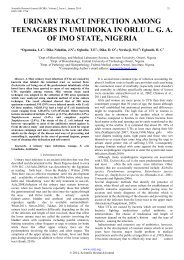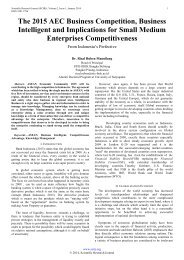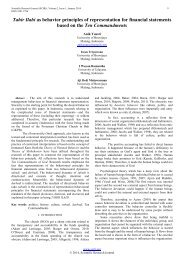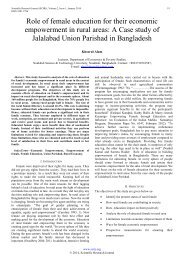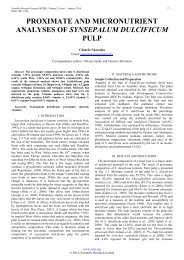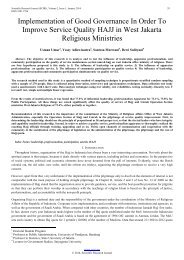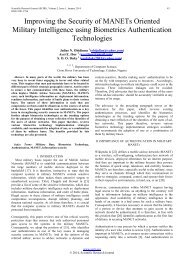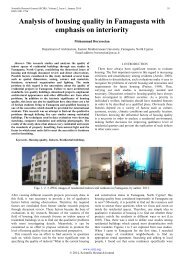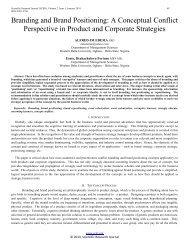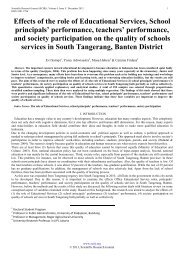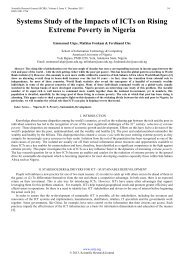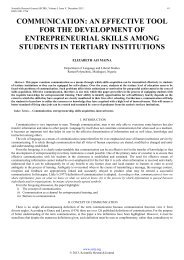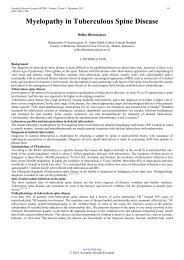RELATIVE EFFICACY OF ARTESUNATE OR AMODIAQUINE COMBINATION THERAPIES WITH SULPHODOXINE-PYRAMETAMINE IN CHILDREN WITH UNCOMPLICATED PLASMODIUM FALCIPARUM MALARIA IN BORNO STATE, NIGERIA
The study was carried out in the malaria holo-endemic settlements around Lake-Alau, Borno State, Nigeria between July to December, 2011. The aim was to compare the efficacy of Artesunate + Sulphadoxine-Pyrimethamine (AT+SP) and Amodiaquine + Sulphadoxine-Pyrimethamine (AQ+SP) in the treatment of uncomplicated Plasmodium falciparum malaria in children. A total of 313 children (6-59 months) were screened, using standard protocols for therapeutic efficacy studies on fever and parasitaemia and the results were evaluated using regression analysis. The results obtained indicated that 79.6% of the children were cleared of fever by AT+SP as against 78.3% by AQ+SP on the first 24 hours after treatment and achieved a daily rate of temperature clearance of 0.35 0C and 0.29 0C and daily reduction in febrile children of 22.04% and 21.99% with the respective drugs, within the early follow-up days (0 - 3). The remaining febrile were relieved by day 28 and temperatures normalized to 36.0 0C and 36.7 0C with the respective drugs. The results further revealed that both AT+SP and AQ+SP cleared the bulk of the parasites from 21,738 to 30/µl and 19,953 to 66/µl, respectively within the first three days of follow-up; with proportionate success rates of 85.1, 95.2, 99.0, 99.5, 99.9 and 99.9% and 78.7, 93.4, 98.4, 99.4, 99.6 and 99.7% on days 1, 2, 3, 7, 14 and 28, respectively. These translates to mean parasite clearance time of 28.45 hours and 29.92 hours, with concomitant mean fever clearance time of 29.36 hours and 31.65 hours in AT+SP and AQ+SP, respectively. Regression analysis further revealed that each µl of the blood parasites cleared gave a temperature relief of 0.2071 0C and 0.1714 0C with the respective drugs. These results clearly put the efficacy of AT+SP in fever clearance ahead of AQ+SP in both early and late follow-up days. Based on rapid parasite and fever clearance accompanied by faster PCV (%) recovery and higher frequency of adequate clinical and parasitological response (ACPR) of AT + SP (91.4%) it could be adjudged to be superior to AQ+ SP (84.5%). Therefore, the Artesunate based combination therapy (AT + SP) is recommended for control of P. falciparum malaria in children.
The study was carried out in the malaria holo-endemic settlements around Lake-Alau, Borno State, Nigeria between July to December, 2011. The aim was to compare the efficacy of Artesunate + Sulphadoxine-Pyrimethamine (AT+SP) and Amodiaquine + Sulphadoxine-Pyrimethamine (AQ+SP) in the treatment of uncomplicated Plasmodium falciparum malaria in children. A total of 313 children (6-59 months) were screened, using standard protocols for therapeutic efficacy studies on fever and parasitaemia and the results were evaluated using regression analysis. The results obtained indicated that 79.6% of the children were cleared of fever by AT+SP as against 78.3% by AQ+SP on the first 24 hours after treatment and achieved a daily rate of temperature clearance of 0.35 0C and 0.29 0C and daily reduction in febrile children of 22.04% and 21.99% with the respective drugs, within the early follow-up days (0 - 3). The remaining febrile were relieved by day 28 and temperatures normalized to 36.0 0C and 36.7 0C with the respective drugs. The results further revealed that both AT+SP and AQ+SP cleared the bulk of the parasites from 21,738 to 30/µl and 19,953 to 66/µl, respectively within the first three days of follow-up; with proportionate success rates of 85.1, 95.2, 99.0, 99.5, 99.9 and 99.9% and 78.7, 93.4, 98.4, 99.4, 99.6 and 99.7% on days 1, 2, 3, 7, 14 and 28, respectively. These translates to mean parasite clearance time of 28.45 hours and 29.92 hours, with concomitant mean fever clearance time of 29.36 hours and 31.65 hours in AT+SP and AQ+SP, respectively. Regression analysis further revealed that each µl of the blood parasites cleared gave a temperature relief of 0.2071 0C and 0.1714 0C with the respective drugs. These results clearly put the efficacy of AT+SP in fever clearance ahead of AQ+SP in both early and late follow-up days. Based on rapid parasite and fever clearance accompanied by faster PCV (%) recovery and higher frequency of adequate clinical and parasitological response (ACPR) of AT + SP (91.4%) it could be adjudged to be superior to AQ+ SP (84.5%). Therefore, the Artesunate based combination therapy (AT + SP) is recommended for control of P. falciparum malaria in children.
You also want an ePaper? Increase the reach of your titles
YUMPU automatically turns print PDFs into web optimized ePapers that Google loves.
Scientific Research Journal (SCIRJ), Volume I, Issue II, September 2013 37<br />
ISSN 2201-2796<br />
Fig. 3: Effects of parasitamia on PCV in P. falcifarum infected children<br />
treated with a) AT+SP and b) AQ+SP during follow-up period<br />
IV. DISCUSSION<br />
Parasite biomass and temperature at different follow-up periods serves as a strong indicator of drug performance. The present result<br />
revealed rapid fever clearance and parasitological cure with both drugs, however, the high parasite density at enrolment coupled<br />
with faster clearance rate by AT+SP during both early and late phases suggest its higher efficacy over AQ+SP. Previous reports<br />
also rated the Artesunate arm as the most rapid of all available antimalarial drugs in the initial reduction of parasitaemia (Nosten et<br />
al., 2003; Bukirwa et al., 2006; Nahum et al., 2007). The faster speed of Artesunate arm in parasite clearance could be attributed to<br />
its active and potent effects on the early ring stages of plasmodium and early-stage gametocytes shortly after drug administration<br />
(Reichmann et al., 1989). Pharmokinetic studies revealed that Artesunate is rapidly and quantitatively converted in vivo to the<br />
potent active metabolite dihydroartemisinin, which also rapidly and substantially reduces the parasite biomass followed by rapid<br />
resolution of clinical symptoms and reduction of gametocyte carriage (Bloland et al., 2003). However, in spite of the sharp parasite<br />
clearance rate, both Artesunate and Amodiaquine arms have a very short half-life and are rapidly eliminated (Nostenet al., 2003),<br />
which suggests that the combination therapy relied on the Sulphadoxine-Pyrimethermine component at the later phase. Reports<br />
suggest that Sulphadoxine-Pyrimethamine further improved parasitological clearance (Gasasira et al., 2003; Zongoet al., 2007;<br />
Adjeiet al., 2008), but Watkins and Mosobo (1993) pointed out that antifolate arm exert little or no effect on the parasites during<br />
the first 24 hours of their life cycle, while Hyde (1990) reported that even in the late phase it affects only the actively dividing<br />
forms of Plasmodium species (Schizonts).<br />
The present study did not register early treatment failure (ETF) with either of the drugs or late clinical failure (LCF) in AT+SP.<br />
Reported cases of ETF in respect of the drugs are equally low ranging 0-1.7% (Zongo et al., 2005; Blair et al., 2006; Bonnet et al.,<br />
2007; Mukhtar et al., 2007; Ménard et al., 2007; Nahum et al., 2007; Sowunmi et al., 2007). Similarly, reported LCF did not<br />
exceed 5.0% (Gasasira et al., 2003; Zongo et al., 2005; Blair et al., 2006; Faye et al., 2007; Nahum et al., 2007; Ménard et al.,<br />
2007; Mukhtar et al., 2007; Sowunmiet al., 2007). The present result relatively revealed lower frequency of late parasitological<br />
failure (LPF) in AT+SP (8.6%) than AQ+SP (14.9%). Values obtained in the present study fall within the reported ranges of 0 -<br />
10.4% for AT + SP (Nahum et al., 2007, Mukhtar et al., 2007) and 0 - 16% for AQ + SP (Talisuna et al., 2004; Zongo et al., 2005;<br />
Molta et al., 2006; Tagboret al., 2006; Faye et al., 2007; Ménardet al., 2007; Sowunmi et al., 2007). TTF was found to be relatively<br />
higher for AQ+SP (14.96%) than AT+SP (8.6%), the values in other reports were lower with 1.0 - 3.4% occurrence for AT + SP<br />
(Blair et al., 2006, Bonnet et al., 2007) and 2.2% in AQ + SP (Blair et al., 2006). The result on adequate clinical and parasitological<br />
response (ACPR) was in favour of AT+SP with 91.4% compared to 84.5% for AQ+SP. Most reports indicated 91.2 - 99.1% ACPR<br />
for AT + SP (Dorsey et al., 2002, Hamour, 2005, van den Broek et al., 2005, Blair et al., 2006, Bonnet et al., 2007, Nahum et al.,<br />
www.scirj.org<br />
© 2013, Scientific Research Journal





